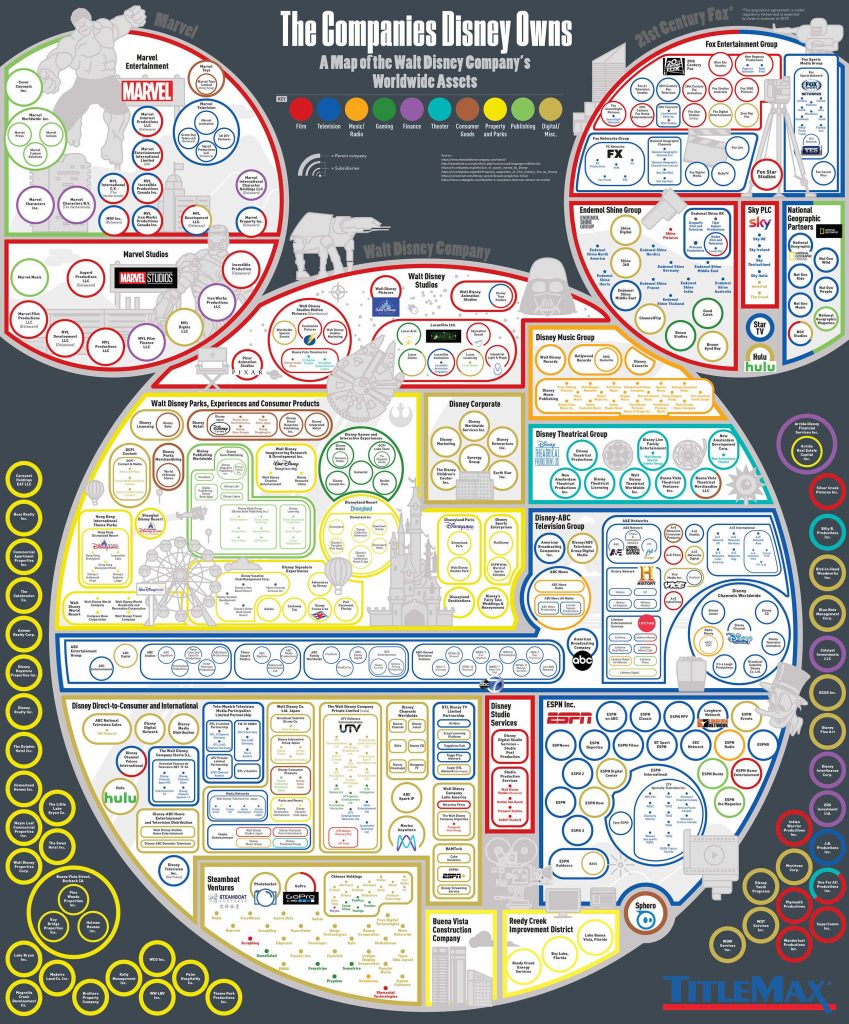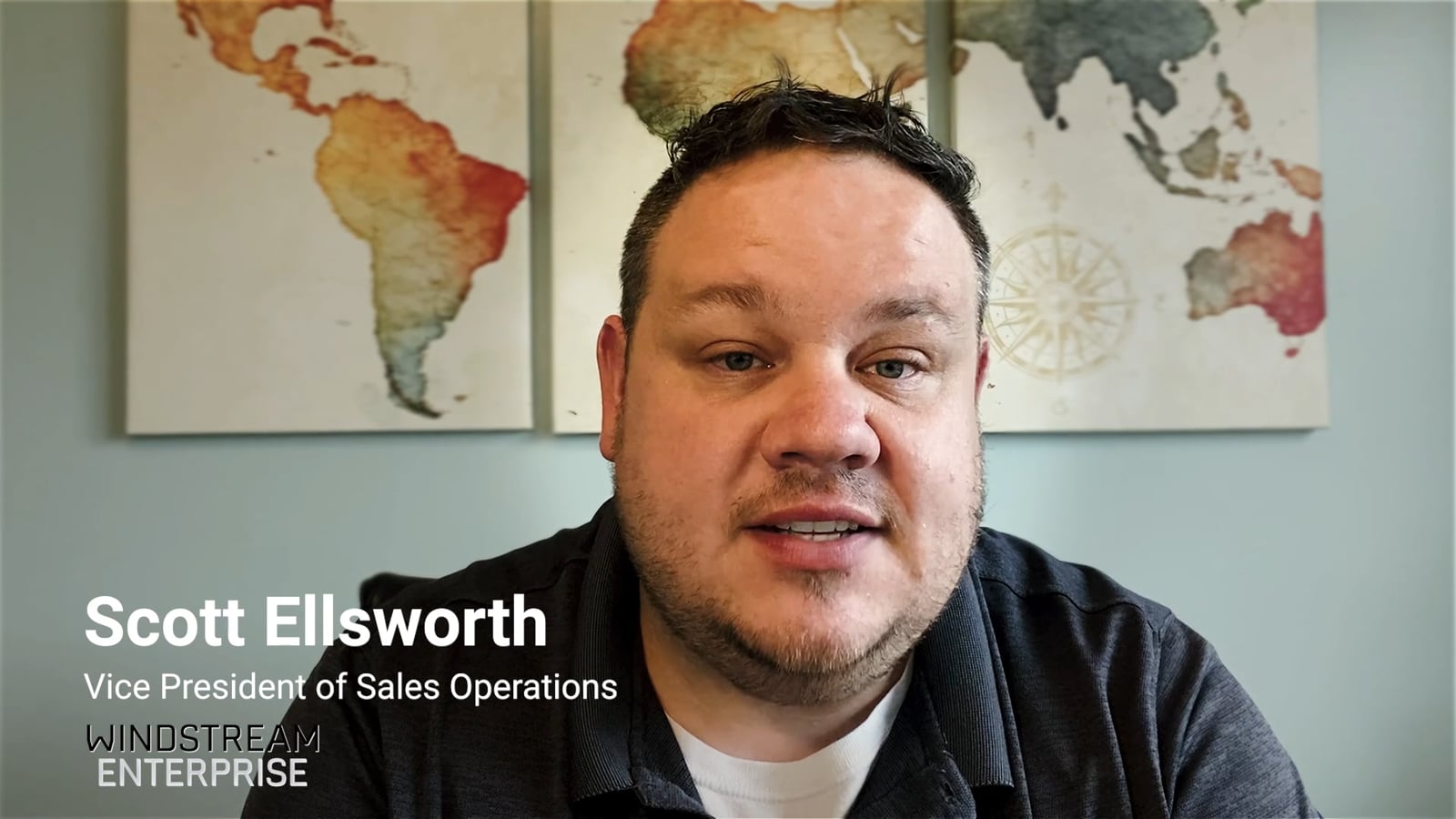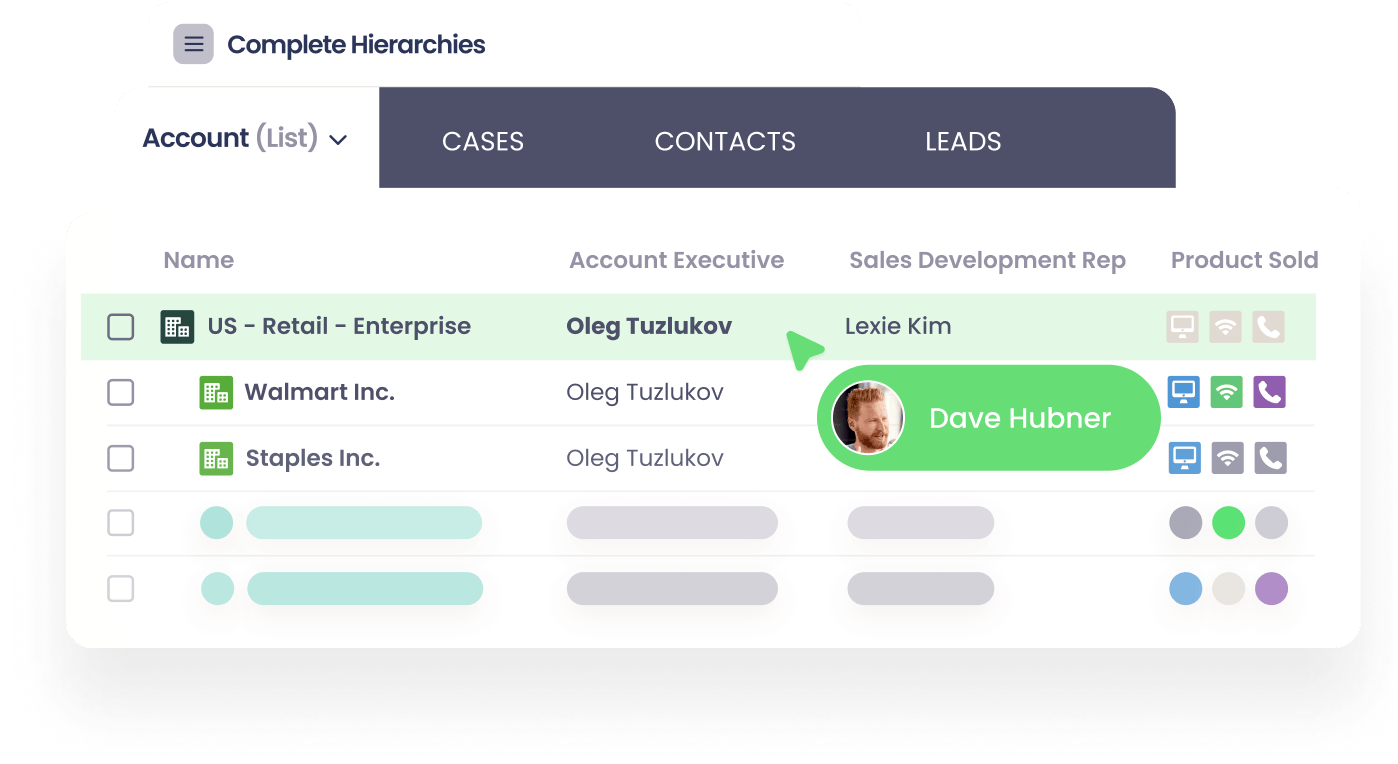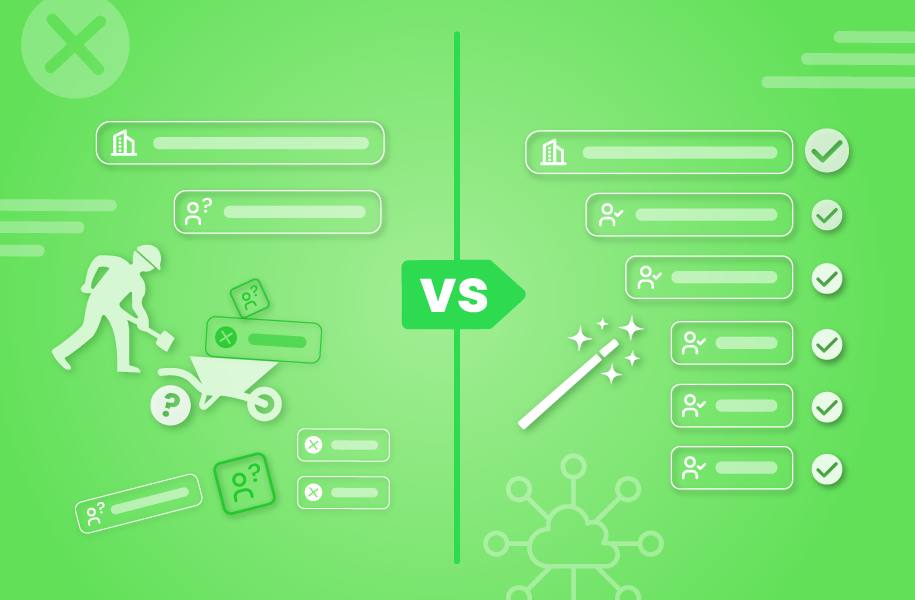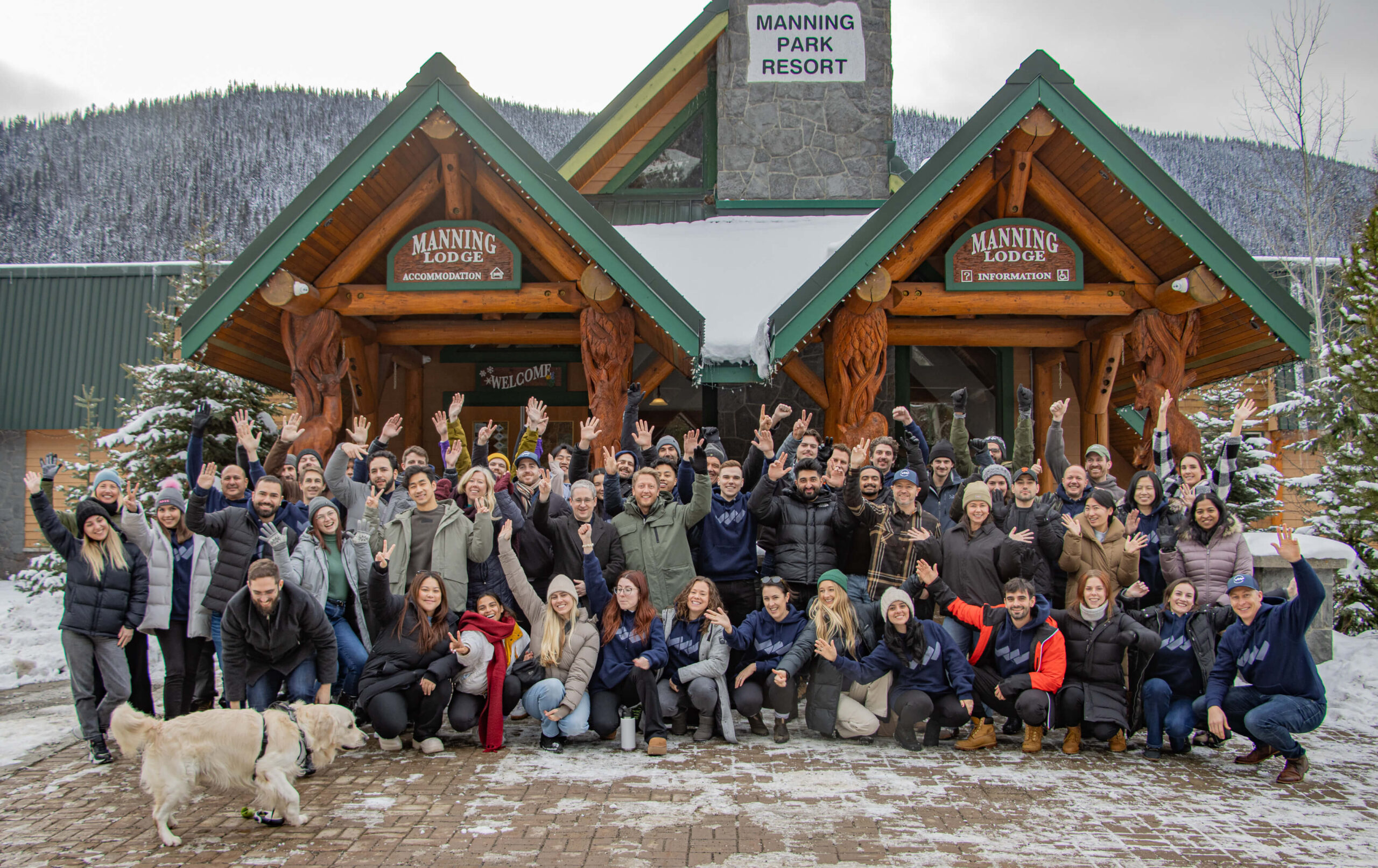The Secret of Selling Into Complex Enterprises: Account Hierarchy in Salesforce
Life’s complicated.
When you’re working for a large organization selling to other large organizations, life gets, well, even more complicated.
As your customers grow into gnarly, complex enterprises with subsidiaries that often go through mergers and acquisitions, not to mention parent-child accounts becoming grandchild and great-grandchild accounts – answers to even the simplest questions are complex.
In a sea of Salesforce customer data, you might find yourself asking:
- Which accounts are a part of the same corporate entity?
- How much business are we doing with individual accounts and combined accounts that are a part of the same family tree?
- How many reps are assigned to accounts within the same account hierarchy? Is there overlap?
- Where are the ‘whitespace’ opportunities within my key target accounts and their hierarchies?
The list goes on.
What’s more? This complexity grows as your business grows.
Your customer data mounts, duplicates, and drags you down as you’re left scratching your head and scouring spreadsheets – instead of spearheading your move-the-needle initiatives.
In order to ensure your data is spotless, no opportunities slip through the cracks, and your revenue teams are running like a well-oiled machine – you need superhuman-like powers.
Ok so we’re not a machine, nor are we Iron Man, with a perfect snapshot of data being organized right before our eyes.
However, we do need an iron-clad strategy for dealing with the complexities of the relative world of RevOps and customer data:
- Messy, misaligned data leading to blood, sweat, and spreadsheets
- No shared source of data truth across departments
- Customer data is not visible or actionable for revenue teams
- Frustrating to report on who your largest customers are, and how much business they are doing with you across hierarchies
- Almost impossible to do accurate whitespace analysis across key target accounts and the hierarchies they belong to
All in? Creating a cohesive data environment for your organization can feel out of reach and as your business scales.
Ahem, now for the good news.
Supercharging revenue with clear, connected customer data in Salesforce is possible.
If go-getter giants such as Google, Docusign, and Zoom are supercharging revenue and accelerating growth with all of your account hierarchies in Salesforce at superhuman rates, you can too.
Let’s break it down, but first – a deeper dive into what the heck hierarchies are, and why you should give a $&@!.
Skip ahead to the next section if this sounds a little 101 to you.
What Is An Account Hierarchy in Salesforce and Why The Heck Should You Care?
If you are selling to enterprise-size companies, account hierarchies are mission-critical. – Steven Tan, Sales Operations, ON24
If you’re in RevOps or Sales Ops at a company that sells into enterprise businesses – you most definitely care. You care because an account hierarchy provides a complete and connected view of your largest customer accounts, their contacts, opportunities and more all in one place inside Salesforce.
You know, the big dogs. Companies with countless departments, subsidiaries, and branches.
A classic example – Disney.
You can see that Disney owns a lot of businesses. Disney’s businesses own a lot of businesses. Yup, that’s ESPN sports.
So why is understanding your biggest customers, your Disneys and any associated accounts, so critical?
Account Hierarchy Impacts Your Revenue
Most importantly, your “big dogs”, or large enterprise customers, have a direct correlation to your revenue potential:
20% of your customers generate 70% of your revenue.
They’re the customers you can’t afford to screw up, and they’re your biggest opportunity to scale.
It’s not obvious at all, from either the name or the website of each company, that Disney owns ESPN, Hulu, or even Fox. Without a clear, connected account hierarchy, accounts are separated.
This can lead to lost revenue:
The average sales team loses around 550 hours a year from bad prospect data, equating to approximately $32,000 annually per sales rep.
Source
Without manually “Googling” in Salesforce between related accounts to figure this out, your team blindly engages with customers, missing the bigger picture, and directly impacting sales opportunities.
Not to mention:
The probability of selling to a new prospect is as low as 5% while selling to an existing customer is as high as 70%.
Source
When all of your Disney’s in Salesforce are connected, visible, and reportable, you’ve opened up a whole lot of untapped revenue potential within your existing customer accounts.
How?
With connected account hierarchies, answering those big dollar Iron Man-esque questions becomes possible:
- Who are my largest customers by size or revenue?
- Where are the cross-sell, and up-sell opportunities?
- Where are the whitespace opportunities within my customer hierarchies?
- Based on the answers to the above, where should we be focusing our marketing and sales resources?
- Are my territories evenly balanced when you take account hierarchies into consideration?
We’ll get to more on how to operationalize this later.
Need another reason to care?
Account Hierarchy Impacts Your Entire Organization
Since disconnected data is enemy #1, your entire organization is on the defensive from bad data with no clear visibility into your largest accounts.
Our sales model has changed in a way that it’s very important for the sales reps to be able to see all the subsidiaries under a particular account.– Jim Maddision, Business Systems Analyst, Veracode
Take a look at how disconnected data is a challenge for every department in your revenue organization:
| Team | Impact |
|---|---|
| RevOps | Time and money wasted manually sifting through Salesforce, connecting accounts, managing spreadsheets, and sewing territory planning together. Do it yourself, don’t do it at all, or lose $ hiring a dedicated data team. |
| Leadership | No accurate understanding of your largest business drivers means, you can’t make data-driven business decisions. You look to RevOps to, well, figure it out! |
| Marketing Ops | Living on an island of your own, you miss attributing account-based marketing opportunities and have no visibility into who your largest customer audience actually are. Opportunity is not knocking… |
| Sales Reps | “Googling around” in Salesforce to understand what accounts are related to other accounts, and where the opportunities are. I mean, why even try? |
| Customer Success | Zero visibility into connected accounts means the doors are closed between your current customers and any cross-sell or up-sell opportunities. |
| Data teams | You’re working with data you just can’t trust. Third-party integrations, duplicate data, and inaccurate processes are holding your team back from doing important work. |
Account Hierarchy Impacts Your Data-Driven Decision-Making
What’s the point of having a compass if you’re not going to use it to go in the right direction? You’ve got the data, arm yourself with the insights, right?
We were at our wits end, trying to navigate a really complex data environment.– Scott Ellsworth, VP Sales Ops, Windstream Enterprise
Easier said than done when you’ve got constant mergers, acquisitions, poor naming conventions, duplicate records and various company structures that muddy the waters and leave manually entered and disconnected data quickly outdated.
Without clean, connected account hierarchy in Salesforce, you’ve got no single source of truth and or reliable way to both report and strategize on your largest customers.
In short, you’ve got:
How on earth are you supposed to figure out what move to make next, what account to target, what business decision to make – all without a trusted data source of truth?
With disorganized data, searching for customer insights is like blindly reaching into the gumball bin looking for only the red ones.
And this is just the root of the sticky problem.
Breaking Free From Bad Data: Defense to Offence With Account Hierarchy in Salesforce
That gumball bin isn’t going to organize itself.
Do you:
- Play defence against bad data until the end in Salesforce,
- Pull out your strategic offensive advantage with automated account hierarchies as your superpower.
Here’s the difference:
| Manual effort and time spend dealing with bad data | Organize your accounts and make dealing with dupes possible |
| Ever-changing business needs and the inability to make go-to-market critical updates quickly. | Transformed territory planning with no more rep overlap and conflict or territory splits |
| Hard to uncover opportunities inside your related customer accounts | Identify whitespace opportunities and grow total sales across the entire organization |
| Inefficient sales reps | Sales reps can spend more time selling (agents spend as much as 40% of their time trying to find the right person to call). |
| Time lost on manual work (the blood, sweat, and spreadsheets) trying to understand customer insights | Report across family trees and Salesforce organizational structure in order to make better strategic account decisions. Lift speed to sale and identify key decision-makers (KDMs) earlier. |
| Spending money on keeping your data clean when it’s vastly outdated and not helpful for your ABM strategy | Allocate Account-Based Marketing (ABM) spend intelligently and gain accurate customer insights |
Before you desperately sing “I need automated account hierarchies!” Bonnie Tyler-style, there’s more.
Using Your RevOps Superpower: Automated Account Hierarchy in Salesforce
Let’s take a look at how account hierarchies can actually shift your business for the better, ultimately establishing a strong data foundation to help you scale and supercharge revenue.
Wield your superpower to:
- Unlock your data potential (stop defending against bad data)
- Make better business decisions (insights, insights everywhere!)
- Speed up and sell more (and look good in front of prospects)
- Align your organization on a killer account-based strategy
Here’s how.
1. Unlock Your Data Potential
Because it all starts with data.
Automated account hierarchies are your key to unlocking your data potential and getting your desperately needed single source of customer truth. How?
Enter what’s called a Complete Company ID, the account hierarchy unique identifier used by Complete Hierarchies.
Here’s three reasons you should be utilizing a unique ID:
- A clear definition of who the customer is – Every department including sales, marketing, and finance has a different purpose or utilization of customer data in Salesforce.
- Alignment with third-party applications or BI’s – To align data living outside of salesforce on third-party Business Intelligence applications, you need a unique identifier like the Complete Company ID. Otherwise, it can feel like an impossible data environment if you don’t have a single source of truth across platforms.
- Better data enrichment – If you have a Complete Company ID, you can get better matches from your data enrichment tool. You can be confident you’re not filling your Salesforce with duplicate accounts and are keeping a clean cohesive environment.
Here’s how it works.
First, automatically connect and cleanse with account hierarchies:
- When you’re using a data enrichment tool to cleanse your data set, hierarchies will help you see what the results of the cleanse will actually look like in Salesforce
- Once you’ve connected your data using account hierarchies, you can use the custom hierarchy builder to identify any incorrect matches mistakes or gaps in your data and fix them
- You can then use hierarchies to identify account duplicates and easily merge them
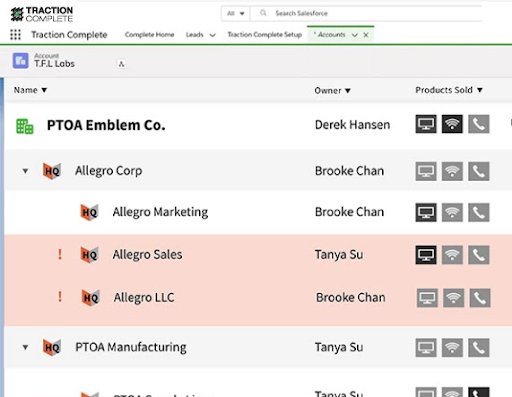
In short, with the click of a button you now have clean, connected customer data. Did we mention, automatically?
It’s a game-changer in the world of territory disputes & messy account hierarchies!– Hazel Tran, Director of Global Territory Strategy & Sales Operations, Docusign
This all gives you a ton of data to leverage – hence we give you… #2 must-do with account hierarchies:
2. Use Your Data To Drive Decision-Making
A crucial aspect of RevOps is reporting – the cost of customer acquisition, customer churn rate, monthly and annual recurring revenue, win rates, forecasts…
Leaders can report on individual account revenue using native Salesforce tools, but rolling up this data into a revenue report across the entire corporate family tree is a brain-busting manual task.
To provide these valuable insights to other leaders and use them to form revenue-generating strategies, you need to be able to pull that data quickly. You also don’t want to have second thoughts about your calculations.
You need each subsidiary, or child account, to be associated with the correct Complete Company ID, or global ultimate account.
(For example, Disney):
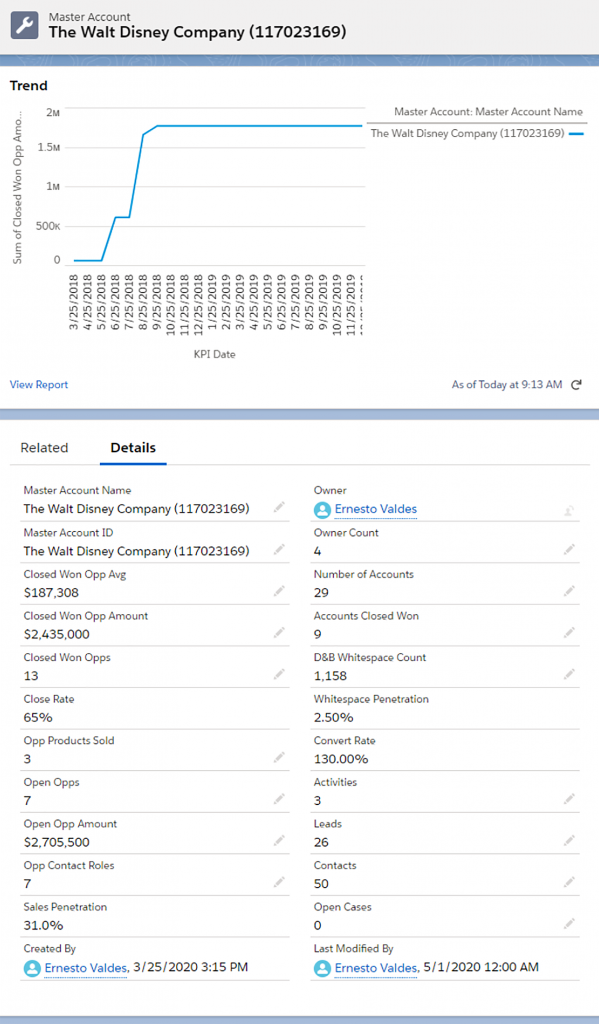
You can see that our current revenue from The Walt Disney Company (including all of its subsidiaries and divisions) is just shy of $2.5m. We also have $2.7m worth of open opportunities. Knowing that we have a 65% Close Rate with Disney, we can expect to close about $1.75m of this.
No more hmm-ing or haww-ing. You know the numbers are accurate across the entire family tree.
Imagine all you can report on, and how quickly you can do it – spreadsheets, pshh, as if!
Leadership asked you to pull that report, well, yesterday? No problem!
Insights are now your superpower.
3. Speed Up And Sell More
Data unlocked? Check. Data engaged? Check. What’s next?
No time but now to accelerate!
Because sales now has a holistic view of customer data in a single location, with up-to-date contact information and an accurate display of corporate structures, they are easily able to identify insights that will help them close cross-sell and upsell deals.
Here’s how:
- Easily understand what products have been sold into their key accounts across an entire account hierarchy
- Create a more personalized selling experience – recommend and identify products based on a complete picture of their selling history across complex hierarchies
- Realize larger deals by having conversations with stakeholders involving Salesforce parent child relationship at any level of a hierarchy.
Opening the floodgates to more cross-sell and up-sell deals is just the start. You can also use automated account hierarchies to identify whitespace opportunities.
What methods are you using to identify whitespace right now?
You’re probably relying on:
- Intel from your sales reps
- Context from conversations with current customers
- Search engines
- Tarot cards
- Tea leaves
Not anymore. Simply click the ‘View All Whitespace’ icon on subsidiary accounts within Complete Hierarchies to crawl through your entire platform and unlock previously unseen accounts hiding within your customer’s ecosystem.
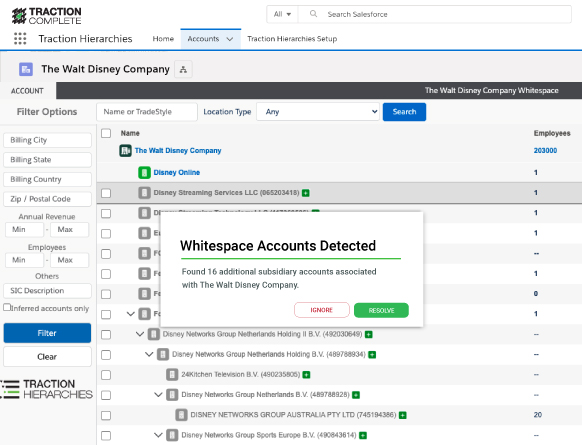
You’ve identified your whitespace accounts. Now you should leverage your current relationships to drive sales opportunities.
73% of execs feel more comfortable working with salespeople who have been referred by someone they trust.
Sales reps can, for example, discover that a former colleague in fact works at a subsidiary of the account they’re currently targeting, and can ask for an introduction. By leveraging your network with customers, you can turn what would have been cold calls into warm introductions.
Oh and now that you know who your largest customers really are, you can give them the “white glove” treatment they deserve.
It’s in your best benefit to treat your customers like they matter most to you.
You can see how account hierarchies shifts your strategy and influences how you go-to-market, speed up, and sell more.
Faster sales? Automate it. Smarter selling? Uncover whitespace opportunities.
It’s probably best if you hear it from Scott, VP of Sales Operations at Windstream Enterprises.
Enter Scott Ellsworth
Scott and Windstream Enterprise were able to break free from bad data and uncover a holistic view of their largest customer accounts.
The network and connectivity services provider faced some serious challenges:
- 4 million customer records with no organization or way of linking the accounts together
- Sales rep overlap, sometimes accidentally assigning 4 to 5 salespeople on one account
- No way to clean up the messy, misaligned, incomplete data
These challenges weren’t just soul-destroying for the teams having to wade through the database, but they were directly leading to losses and missed opportunities for the business.
After implementing Complete Hierarchies, these were the results:
| 4 million customer data points down to 200,000 | Reduced data footprint and a Complete Company ID, or global ultimate account, that can be relied on as a single source of truth as they scale |
| Complete visibility for Windstream’s 400+ salespeople | Reps can quickly identify records, find information, understand account relationships They can identify cross-sell and up-sell opportunities and apply account-based intelligence to sales and marketing |
| Minimized time spent on manual tasks | Maximized time spent on meaningful sales calls, strategies, and collaboration |
| Better data, better decision-making | RevOps can determine who their largest customers are, where they should be doing business, and produce roll-up reports on complex enterprise accounts |
Conclusion: Don’t Use Account Hierarchies in Salesforce Yet? Are You Okay?
With native Salesforce, you’re trudging through a warzone of duplicate, chaotic, incorrect data. And you’re doing it all manually.
Yes, manually. Tap, tap, tapping on your keyboard for days, months, years, correcting hundreds or even thousands of accounts.
Reporting? Automation? Whitespace? Forget it. You’re living and breathing spreadsheets.
There’s a lot more under the hood here, but really, we know a RevOps model needs to align all organizational departments around one shared strategy – but to do that, you need connected customer data and a single source of truth that an automated account hierarchy can solve
It’s scary that this is such a complex, painful problem yet this functionality didn’t exist in Salesforce before. It’s no wonder that the biggest challenge facing RevOps teams is incorrect, fragmented, and outdated data.
It begs the question, how have you been navigating the data disarray before finding this article?
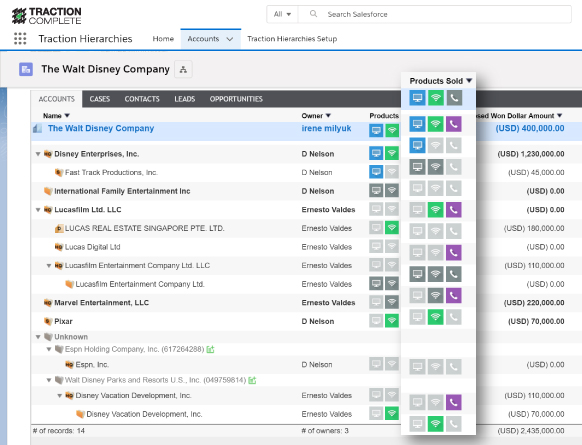
It’s time to get a clearer picture of your largest customers and operationalize the data that is right in front of you for your entire revenue organization.


